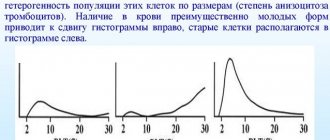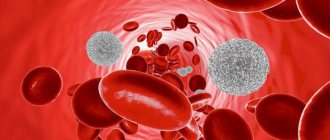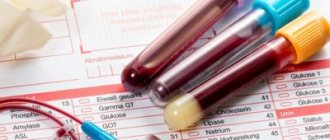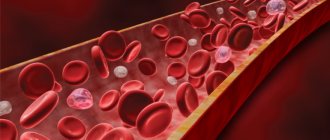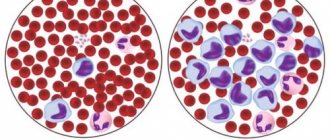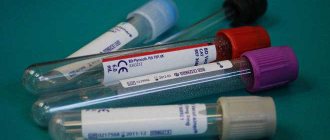Experienced doctors can tell about the patient’s health based on the condition of leukocytes. A person cannot independently identify this indicator. To read the analysis correctly, you need to understand what leukocytes in the blood are responsible for and know the permissible fluctuations of this indicator. You should also know what is worse: going beyond the lower or upper limit.
What are leukocytes
Human blood is a connective, mobile tissue, divided into a basic liquid medium called plasma, as well as dense elements, which include:
- platelets;
- red blood cells;
- leukocytes.
What are leukocytes in the blood responsible for? In general, leukocytes are white blood cells that make up the middle layer of a gray hue in the settled part. If you examine blood in a laboratory setting under multiple magnification, the leukocytes look like small spheres that have an irregular shape and a rough surface. The white tint of leukocytes is due to the lack of color, which cannot be said about erythrocytes.
Leukocytes are synthesized, like other blood cells, by the bone marrow. The total amount of all formed elements in human blood is no more than 50%. The number of leukocytes should be an order of magnitude less than erythrocytes and platelets.
What are leukocytes in the blood designated as? Their letter designation in a blood test is WBC - White Blood Cells.
Eosinophils
Eosinophils (designated EO) are the second type of cells of the leukocyte series, which are continuously formed in the human bone marrow. After maturation, they leave the bone marrow and move through the circulatory system into tissues, where they destroy proteins foreign to the body.
If an indicator of this type is elevated (has the corresponding designation of leukocytes in a blood test), then this indicates that the body is actively fighting harmful microorganisms that have entered the blood. A decrease in the level of eosinophils in the blood is observed during the course of acute infectious diseases. If, after a long absence from analysis, they begin to appear again, this means that the person is beginning to recover.
What are leukocytes in the blood responsible for?
These bodies play a huge role in the protective functions of the human body, as they participate in immune reactions and synthesize special T cells - lymphocytes. Speaking about what lymphocytes in the blood are responsible for, it should be noted that they recognize infectious agents that enter the human body, and then destroy them. If the process of releasing lymphocytes from leukocytes has been carried out correctly, then the immune system is stimulated to produce special antibodies, which is very important in the presence of infectious diseases, as well as any inflammatory processes. If someone does not know what leukocytes in the blood are responsible for, then their main role is to protect the body.
Monocytes
Monocytes are the largest form of white blood cells. Their main function is, together with neutrophils, to fight pathogenic and foreign organisms. But since the size of monocytes is much larger, they live and destroy harmful bodies much longer than neutrophils.
The identification and designation of leukocytes in a blood test of this type is a rather important process, since an increased level of monocytes is a direct sign of a disease such as infectious mononucleosis, and their absence indicates the occurrence of severe inflammatory and infectious diseases in the body, including bone marrow damage.
The norm for monocytes (for an adult) is 3-11%.
How long can they live?
The lifespan of each form of leukocyte is different. For example, granulocytes begin to die within 10 days; lymphocytes, which are especially important for the immune system, function in the human body for several years, after which they are replaced by new ones.
Monocytes have the shortest lifespan, which is 1-2 hours. This is due to the fact that they are faced with the simplest task.
All forms of leukocytes are destroyed in the spleen or in the area of the inflammatory process.
Reasons for decreased hemoglobin
- Blood loss.
Acute bleeding due to injury, surgery or chronic internal, uterine bleeding.
- Bone marrow dysfunction.
Insufficiency of erythropoiesis, cancer.
- Iron deficiency in the body.
- Metabolic disorders due to lack of vitamins, microelements, enzymes, etc.
- Hemolysis of red blood cells.
Rapid destruction of red blood cells due to their inferiority or damage by immune complexes.
- Hemoglobinopathies.
Congenital disorders of hemoglobin synthesis.
Types of leukocytes
The main indicator that determines the state of human health is not only the total number of leukocytes, but also the percentage of their types, according to which experts put forward various hypotheses about the reasons for the deviation from the norm. The main types of white blood cells include:
- Neutrophils. These elements are included in the number of granular leukocytes. If their level falls, this will lead to the loss of the human body’s ability to protect itself from various direct and bacterial infections. Neutrophils that have died appear as pus at the site of inflammation.
- Lymphocytes. Lymphocytes are the main defenders of the human body in the presence of viral infections. They are the ones who destroy and recognize foreign agents.
- Monocytes. The main role of monocytes is that they cleanse the inflammation site from dead various foreign particles.
- Basophils. Basophils are considered auxiliary cells that mobilize other granular leukocytes to the main site of the inflammatory process.
- Eosinophils. These granulocytes perform an antiallergic function in the human body.
What is hemoglobin indicated in a blood test?
The results of blood tests are used by specialists from all fields of medicine to diagnose, monitor the course of the disease, and change the prescribed treatment if necessary. Changes that occur in the body when various diseases occur are reflected in the values of indicators in the results of blood tests, which makes it possible to identify various diseases of the internal organs of a person in the early stages. Blood tests determine abnormalities during pregnancy in women, as well as the condition and development of the fetus.
The results of the analyzes indicate a number of indicators with numerical values. There are certain boundaries of the level of norms for these indicators. Based on deviations from these norms, the doctor can draw a conclusion about changes in a person’s health and prescribe the necessary treatment.
English abbreviations are used as designations in blood tests. Knowing these designations and their acceptable limits, you can easily read the analysis results. However, based on the results of blood tests alone, without consulting a qualified specialist, you should not make an independent conclusion about your state of health.
We will decipher the letter designations in blood tests, indicate the numerical boundaries of the indicators within their norms and indicate the possible causes of deviations.
1. HGB, Hb, Hemoglobin - hemoglobin. Transports oxygen and carbon dioxide to all organs, participates in the regulation of pH levels, and characterizes the concentration of hemoglobin in whole blood. The normal level is 110-160 g/l. A decrease in hemoglobin is associated with anemia, iron or folic acid deficiency. An increased value of the indicator may be a sign of heavy physical exertion, blood thickening, burns, or intestinal obstruction.
2. NCT, hematocrit - hematocrit. Indicates the ratio of red blood cells to blood plasma, but does not reflect the overall value of red blood cells. Normally it is 42-60%. The indicator is increased in congenital heart defects, diabetes, vomiting, and diarrhea. A decrease in the indicator is observed with anemia, in women - in the second half of pregnancy.
3. RBC - designation in a general blood test for the number of erythrocytes, red blood cells shaped like a disk. Red blood cells transport oxygen to tissues and organs and carry carbon dioxide to the lungs. Normally, in men this figure is 4-6 x 1012 l, in women – 4-5.5 x 1012 l. A decrease in the level of red blood cells can be a sign of anemia, and also occurs with major blood loss, deficiency of iron, vitamins B9 and B12.
4. PLT – platelets. Blood plates that prevent blood loss. Participate in the formation of blood clots when blood vessels are damaged. The normal value is 350-500 thousand/mm of blood. A decrease in value indicates increased bleeding.
5. WBC – leukocytes. White blood cells that support human immunity. Normally, their level is 3.5-10 thousand/mm3. Any deviation of the indicator value from the norm indicates the presence of inflammatory diseases in the body.
6. LYM – lymphocytes. Responsible for the content and production of antibodies and immunity to various viruses and microorganisms. Normally, their content in blood plasma is 30%. The increase may be due to tuberculosis, lymphocytic leukemia and various infectious diseases.
7. ESR – erythrocyte sedimentation rate. This indicator characterizes the protein content in blood plasma. The normal level is no more than 17-18 mm per hour. An elevated ESR level is a sign of inflammation.
1. Total protein. It represents the total amount of proteins in the blood; it is involved in blood clotting and the transport of various substances to organs and tissues. Normally it corresponds to values of 64-84 g/l. Exceeding the norm may indicate infections, arthritis, and cancer.
2. Glucose. In a biochemical blood test, it is designated “Glu” or the word “glucose”. Normally it does not exceed 3.30-5.50 mmol/l. An increase in the indicator signals the development of diabetes mellitus. In the body, glucose is responsible for carbohydrate metabolism.
3. Urea. Formed during the breakdown of proteins. Normally it is 2.5-8.3 mmol/l. The value of the indicator increases with kidney diseases, intestinal obstruction, and diseases of the urinary system.
4. LDL, HDL indicate the level of cholesterol in a biochemical blood test, which takes part in fat metabolism, the production of vitamin D, and affects the functioning of sex hormones. The normal limits are 3.5-6.5 mmol/l. This indicator increases with atherosclerosis, cardiovascular diseases, and liver diseases.
5. BIL - bilirubin. The pigment is red-yellow in color and is formed after the breakdown of hemoglobin. Total bilirubin consists of indirect and direct bilirubin and normally corresponds to values of 5-20 µmol/l. A strong increase in the indicator indicates a lack of vitamin B12, the development of jaundice, and cancer.
6. Creatinine. It is an indicator of kidney function and takes part in the energy metabolism of tissues. The normal level depends on the person’s body weight and is 53-115 µmol/l. As a rule, an increase in this indicator indicates renal failure.
7. α-amylase, amylase - amylase. Promotes the breakdown and digestion of carbohydrates. The normal value for α-amylase is 28-100 units/l, for pancreatic amylase – 0-50 units/l. An increase in the indicator may indicate peritonitis, pancreatitis, diabetes mellitus and some other diseases.
8. lipase - lipase. Pancreatic enzyme that breaks down fats. Normally it does not exceed 190 units/l. When deciphering the designations of a biochemical blood test, an increase in the indicator will indicate the development of pancreatic diseases.
9. ALT (ALT) – alanine aminotransferase. A special enzyme used to diagnose liver function. ALT appears in the blood if the cells of the liver, heart, and kidneys are destroyed. Normally, the indicator should not exceed 41 units/l. in men and 31 units/l. among women.
We have given a breakdown of the designations of a biochemical blood test in relation to the most common and standard indicators. Along with these designations, other indicators are found in the blood test for biochemistry: gamma-GT, alkaline phosphatase, LDL (low-density lipoprotein), triglycerides, K (potassium), Na (sodium), Cl (chlorine), C-reactive protein, iron. These values, deviating from the norm, may also indicate disorders in the human body.
As you can see, knowing the designations in blood tests and the boundaries of normal values, you can independently determine whether the indicator is within the normal range. However, do not forget that only a doctor can make a correct interpretation of the analysis.
It got its name from 2 words: Greek haim - blood and Latin globusu - ball. Therefore, two spellings are used for designation in analyses: HB or HGB. It is measured either in moles, or grams per liter, or grams per deciliter.
Sometimes, to clarify the diagnosis, the amount of hemoglobin in the red blood cell and its concentration are measured. In analyzes it is designated by the letters MCH and MCHC, respectively. To diagnose diabetes mellitus, glycated hemoglobin is measured. In a biochemical blood test, it is designated as HbA1C (A1C) and is measured as a percentage of the total.
The amount of hemoglobin in the blood is determined by a general (clinical) analysis.
A complete blood count is taken from a finger or heel (in newborns). To determine glycated HB, samples are taken from a vein.
To get reliable tests for hemoglobin levels, it is better to know in advance how to take it correctly. It is better to take a general analysis in the morning on an empty stomach. Typically, it is recommended to wait 8-12 hours between the analysis and the last meal. During this period, it is advised to drink only water.
There is no need to fast before taking a biochemical test. You can submit it at any time. The results of the general analysis are ready the next day, and the biochemical analysis in 2-3 days.
Hemoglobin has two important components - protein (globin) and non-protein, which includes iron. In the human body, all hemoglobin is found in red blood cells; beyond these limits it is not observed. Globin, forming complex compounds around iron as a whole, is responsible for the entire respiratory system. It supplies oxygen from the lungs to the tissues and transports carbon dioxide back.
Hemoglobin regulates the acid-base balance in blood cells. To ensure normal oxidative processes, hemoglobin captures oxygen during respiration, and after adaptation it is distributed to all tissues. Next, hemoglobin collects all the carbon dioxide from the cells and sends it to the lungs for removal from the body.
Leukocyte norm
The number of these white blood cells is not considered fixed. Even throughout the day, the leukocyte count will fluctuate, as it is closely interconnected with various external factors. What determines the number of leukocytes in the blood? The physiological increase in this indicator is influenced by:
- Times of Day. For example, before going to bed, the level of white blood cells increases in the blood.
- Excess protein foods in the diet.
- Weather conditions, which should also include the immune response to sudden changes in air temperature.
- Pregnancy period.
- Stressful state.
- Menstruation in women.
You should also pay attention to the fact that the constant concentration of these bodies in adults is always lower than that of other formed elements in the blood. For example, if we compare the number of leukocytes with erythrocytes, then the former are a thousand times smaller.
Doctors also note that newborns have a fairly high level of white cells during a blood test, 3 times more than, for example, an adult. However, over time, their rate gradually decreases; the difference between women and men is observed only after the 21st year of life.
Prevention studies
When carrying out any diagnostic measures, a general blood test is a priority:
- In order to prevent diseases, as well as for their timely detection, laboratory blood diagnostics are recommended to be carried out annually.
- Patients with a history of diagnoses of diseases of the hematopoietic system should donate blood at least three times a year.
- The risk group also includes those who, due to their occupation, come into contact with radio-emitting equipment and chemicals, as well as relatives of cancer patients.
Leukocytosis, accompanied by an increase in white cells in the blood, and leukopenia, when their level is reduced, are not independent diagnoses. These conditions do not arise on their own, but indicate that processes are occurring in the body or there are lesions that require immediate treatment.
The therapist will help determine further tactics for diagnosis and treatment; if necessary, he will provide opinions and referrals to specialized specialists. Timely seeking medical help will allow you to get rid of the pathology with minimal or no consequences. In some cases, such promptness will help save the patient’s life, since the level of white cells is the first thing doctors pay attention to when they suspect malignant neoplasms, including those of the circulatory system.
By protecting the body and supporting the immune system, white cells act as a kind of indicator of any disorders that are not visible to the human eye. This is why every medical examination begins with a general blood test.
Elevated white blood cells
Elevated leukocytes in the blood - what does this mean? Before answering this question, it is worth paying attention to the fact that any fluctuations in the level of white blood cells in the blood have their own names in the medical field. For example, an increase in the level of white blood cells is called leukocytosis. By the nature of its prerequisites, leukocytosis can be physiological or pathological. Physiological leukocytosis in women appears during pregnancy, menstruation, and childbirth. In patients of both sexes and all ages, leukocytosis appears due to stress, physical activity and the consumption of certain foods.
If we talk about pathological leukocytosis, then it should be considered in more detail, since it can indicate the presence of dangerous diseases.
Increased hemoglobin level
We have dealt with low hemoglobin. What do indicators that overestimate the norm indicate? This should also alert you and cause you to contact a doctor for clarification and an examination. An increase in hemoglobin may indicate the following body dysfunctions:
- Hemoglobinemia. A situation where destroyed red blood cells end up in the blood plasma.
- Intestinal obstruction.
- Erythrocytosis.
- Excess of vitamins B9 or B12 in the body.
- Cancerous tumors.
- Pulmonary failure.
- Increased blood glucose levels.
Elevated hemoglobin has a bad effect on health. Blood thickening occurs, high viscosity prevents blood flow from circulating properly, hence oxygen starvation. As a result, the formation of blood clots, cardiovascular diseases, heart attacks and strokes. In this case, it is better to exclude foods that have a high iron content from your diet. Do not overuse fried, fatty foods, exclude vitamins B and C. The doctor should prescribe medications that thin the blood.
Possible causes of leukocytosis
What does this mean - increased leukocytes in the blood? In answering this question, you should pay attention to the fact that the fair sex has more reasons to encounter this disease than men. One of the natural prerequisites for this phenomenon is pregnancy, in which deviations of this indicator from the norm are allowed up to 15*10^9 U/l. However, this is not considered a sign of the presence of any disease. The same deviations are allowed if the blood test was taken after eating food or exercising. If an increase in leukocytes does not apply to these cases, then the reasons may lie in the following:
Separately, we should also mention the strong deviation of this indicator, when the number of leukocytes is more than 100,000 * 10^9 U/l. It is during oncology that leukocytes in the blood increase to such levels. Officially, this disease is called leukemia or leukemia. Mostly this problem is diagnosed among children. If the number of leukocytes has increased only to 10,000 * 10^9 U/l, then this may happen due to the presence of an inflammatory process in the human body, the nature of which must be investigated.
Hemoglobin norms in adults, children and pregnant women
In men, due to the characteristics of their body and the production of the hormone testosterone, the level of hemoglobin is slightly higher than in women. The average values of the indicators are given in the following table:
| Age | In men in g/l | In women in g/l |
| From 12 to 15 years | From 120 to 160 | From 112 to 152 |
| From 15 to 18 years old | From 117 to 160 | From 115 to 153 |
| From 18 to 65 years old | From 130 to 160 | From 120 to 155 |
| 65 years and older | From 125 to 165 | From 120 to 157 |
In children under 12 years of age, the hemoglobin level does not depend on gender, and therefore the established standards change only by age category. Average hemoglobin levels in children are:
| Age | Hemoglobin level in g/l |
| From birth to 14 days | From 135 to 200 |
| 2 to 4 weeks | From 115 to 180 |
| 1 to 2 months | From 90 to 130 |
| From 2 to 6 months | From 95 to 140 |
| From 6 months to 1 year | From 105 to 140 |
| From 1 year to 5 years | From 100 to 140 |
| From 5 to 12 years | From 115 to 145 |
On average, at any age and for any healthy person, the overall normal hemoglobin value can be set to range from 110 to 160 g/l. With age, a person's blood begins to thicken and, theoretically, the level should increase. However, in practice, a completely different picture is usually observed, where due to the presence of various diseases in people of the older age group, the level of hemoglobin drops and anemia appears.
During pregnancy, women also experience a decreased level of hemoglobin, but only in the 2nd half of pregnancy is this considered normal. At this time, the total blood volume in the body increases significantly and the bone marrow begins to fail to produce the required amount of red blood cells and hemoglobin. In the 2nd half of pregnancy in women, the acceptable normal value is a hemoglobin level of 110 g/l.
More information about hemoglobin standards can be found here.
What to do
If leukocytes in the blood are increased, what is done in this case? To do this, you will need to conduct a comprehensive examination, which includes:
The underlying cause of the increase in white blood cells must also be addressed, so treatment options will be determined based on the underlying cause of the leukocytosis. In the presence of acute infections, antibiotics may be used, and in case of blood pathologies, chemotherapy will be required. Additionally, the following are also assigned:
Decreased white blood cell count
Data from doctors suggests that deviations from the norm mainly go up, but a decrease in this indicator is also possible. This phenomenon is called leukopenia. As for the physiological prerequisites for this disease, there are few of them. Statistics show that only 12% of Europeans suffer from a congenital form of this pathology. The function of immune cells does not change, so such patients do not need therapy. As for the pathological decrease in the number of leukocytes, the prerequisites for this are very serious.
Causes of leukopenia
If the function of the bone marrow is impaired, then it can no longer produce leukocytes in the required volume, and their indicator drops by two units or more, while remaining at a minimum level for a long time. From analysis to analysis, this indicator begins to decrease. In adults this happens for the following reasons:
A decrease in white blood cell levels may also occur due to the use of non-steroidal drugs and antibiotics, as well as in the presence of sepsis. Low leukocytes in the blood of a child are observed due to a pathological process, which is predominantly congenital in nature. Specialists place special emphasis on:
Leukocyte formula and its decoding in adults
The types of leukocytes are presented in fractions, the reference values of which are indicated in the table below. During the deciphering of the general blood test (CBC), the patient’s leukocyte formula is compared with reference values, since deviations of fractional indicators from the norm have important diagnostic significance.
Table. Normal leukocyte formula values for deciphering CBC in adults
| Factions | Content percentage |
| Basophils | 0 – 1 |
| Lymphocytes | 19 – 37 |
| Monocytes | 3 – 11 |
| Band neutrophils | 1 – 6 |
| Segmented neutrophils | 47 – 72 |
| Eosinophils | 0,5 — 5 |
The table shows that the smallest fraction of leukocytes are basophils - rare immune cells involved in triggering delayed reactions in the form of inflammatory processes. Normally, they should not be detected or should be observed in the blood in minimal quantities. If the indicator exceeds the norm by any amount, this is regarded as the likelihood of developing pathologies:
- ulcerative colitis;
- hemolytic anemia;
- Hodgkin's disease;
- nephrosis;
- chicken pox;
- deficiency of thyroid hormones and others.
An increase in basophil levels is often provoked by hormonal therapy (for example, estrogen medications or those that reduce the activity of the thyroid gland).
Lymphocytes are the second largest fraction of leukocytes after segmented neutrophils. This group is the main “weapon” of the immune system and has at its disposal pathogen-detecting cells, killer and helper cells and other interesting factions.
The state of a reduced concentration of lymphocytes in the leukocyte formula is called lymphopenia, and an increased content of these cells is called lymphocytosis. The reasons for the development of these conditions are varied.
Eozonophilic leukocytosis under a microscope
Monocytes are the largest and most active phagocytes in the blood of peripheral vessels and have an increased ability to intracellularly digest pathogenic macromolecules. A reduced level of these leukocytes in the blood is called monocytopenia, an increased level is called monocytosis.
Neutrophils are the most numerous group of leukocytes circulating in the blood. Mature neutrophils have a full-fledged segmented nucleus, for which they are called segmented. In functionally immature neutrophils, the nuclei lack segmentation and have the shape of an oblong rod, for which they are called band-nucleus. Mature neutrophils are active participants in phagocytosis, accompanied by the death of “spent” leukocytes. A decrease in this fraction in the blood is called neutropenia, an increase in concentration is called neutrophilic leukocytosis (or neutrophilosis).
Eosinophils are a small fraction of leukocytes, which generally do not remain in the blood, but reside in the tissues. The severe condition of the postoperative patient is determined by the reduced level of eosinophils (eosinopenia) in a general blood test with leukocyte formula.
Eosinophilia (increased concentration of these leukocytes) is characteristic of connective tissue diseases, parasitic infestations, immunodeficiency, tumor and allergic conditions, including bronchial asthma.
How to increase white blood cells
If the number of leukocytes has decreased due to weakened immunity, then to increase this indicator you need to adjust your diet. What foods increase white blood cells in the blood? These include:
You should also pay attention to the fact that offal and meat should be removed from the diet.
Additionally, it is also necessary to use drug therapy to increase leukocytes, which is prescribed only by a doctor. Very good results can be achieved after using the following drugs:
- Leukogen, which is completely non-toxic and cannot accumulate. The course of treatment should be 1-3 weeks.
- Leukomax, which is administered subcutaneously, is recommended primarily for neutropenia. It is used strictly under the supervision of a specialist.
Signs of decline
With a decrease in hemoglobin (anemia), the state of health significantly worsens. This is expressed in loss of strength and weakness. People who lead a sedentary lifestyle do not immediately feel these changes, but those who work physically feel them immediately. Signs of anemia are: dry mucous membranes, pale skin, painful, inflamed condition of the surface of the tongue, brittle hair and nails, and the formation of cracks in the corners of the mouth. If you do not pay attention to these symptoms and do not monitor hemoglobin levels in tests, signs of anemia may acquire a neurological component. In such cases, the sense of smell changes, a perversion in taste preferences appears, severe headaches begin, the optic nerves may become inflamed and paresthesia may begin. Children experience disturbances in behavioral reactions and intellectual development. In elderly patients, adaptation mechanisms are reduced, normal blood supply to tissues is disrupted, resulting in fainting and dizziness.
It is important not only to know how hemoglobin is indicated in the test results, but also to be able to increase its low level.
Folk remedies
If leukopenia is not caused by congenital diseases, then the following folk remedies can be used:
- Mix two parts pollen with one part natural honey. Let it brew for 3 days, after which the finished product should be taken one teaspoon in the morning with warm water.
- Drink a decoction based on oat grains for a month. To prepare it, you need to pour three tablespoons of purified raw materials into 300 ml of water, let it brew for 10 minutes, and filter. Drink 50 ml of the prepared product at a time, morning and evening.
In conclusion, it is worth noting that the main function of leukocytes in human blood is to protect the body from various harmful viruses and bacteria. However, a deviation from the norm of this indicator is not always associated with the presence of some disease.
What is hemoglobin
Hemoglobin is a red blood pigment present in the human body in red blood cells, to which it gives a red color. It consists of a protein component, globin, and an iron-containing heme group, each of which binds an oxygen molecule.
In the lungs, oxygen combines with hemoglobin to form oxyhemoglobin. It easily releases oxygen and saturates the blood with it. When blood passes through the capillaries, oxyhemoglobin breaks down and oxygen is absorbed by the tissues. The carbon dioxide released by the tissues combines with hemoglobin and forms carbohemoglobin, which breaks down in the lungs to release carbon dioxide.
The amount of hemoglobin in human blood is constant. Therefore, if the value in the hemoglobin analysis is increased or decreased, then we can talk about the presence of the disease.
